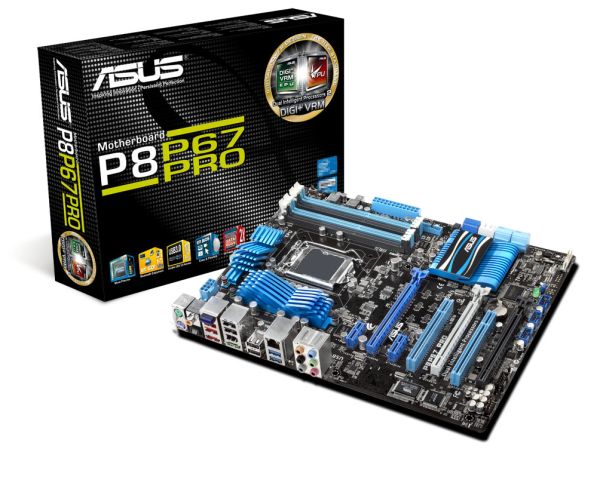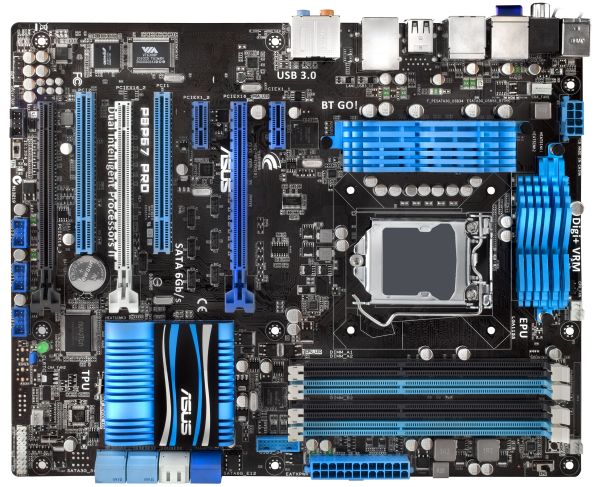A brief look at upcoming ASUS P67 Motherboards
by Ian Cutress on November 14, 2010 1:22 PM EST- Posted in
- News
- Motherboards
- Asus
On first inspection, this board’s aesthetic blue and black livery is impressive. The big blue heatsinks on the VRM, while looking good with a large surface area, intrude slightly on the socket, potentially resulting in restricting the orientation of high end air coolers.
Among the standard features you’d expect on a P67, such as the four dual-channel DDR3 slots, and four SATA 3Gb/s with two SATA 6Gb/s supported by the chipset, there is another two SATA ports, but it is unclear if these are for the RAID, 3Gb/s or 6Gb/s, or how they are powered, as they are not labelled and the chipset heatsink covers quite a bit. Two NEC controllers give two USB 3.0 ports on the back panel, and the possibility for another two via a header on the board connectable to the case, or to an ASUS USB 3.0 port box (as shown in the P67 Deluxe images). The Sandy Bridge platform on P67 relies on discrete graphics only, and as such there are no video out connectors on the back panel, but two PCIe x8 slots on the board itself (or one PCIe x16 if only one card is used). There is another PCIe slot available, presumably x4, for non-GPU duties.
The back panel itself is fairly standard – dual PS/2 ports for keyboard and mouse, S/PDIF out, six USB 2.0 ports, two USB 3.0 ports, two eSATA connectors, firewire, 5.1 audio and gigabit Ethernet. Also of note is the Bluetooth receiver, which is a nice addition, but the lack of a second gigabit Ethernet port, which by now we feel should be a staple on all high end boards and any board with the ‘Pro’ moniker, isn’t too pleasing.
On the board, we see two switches for TPU (TurboV Processing Unit) and EPU (Energy Processing Unit). The TPU is designed to monitor FET thermal temperatures, while the EPU will moderate power appropriately across the VRMs. Both can be turned on and off by the onboard switches, and presumably in the BIOS as well.
Speaking of switches, we’re disappointed that ASUS have not put easy-to-use power and reset switches on the Pro. Sure, not everyone needs them, but they are a nice addition rather than having to short two front panel pins with a screwdriver (when slightly tired, it’s never a good idea to accidentally short the wrong pins, unless you want to see some sparks).












53 Comments
View All Comments
AnnihilatorX - Sunday, November 14, 2010 - link
"Surprisingly, only one 8-pin 12V connector is on the board, which is somewhat odd if the board has a liquid nitrogen mode and power needs to be pumped into the CPU."Just on the right hand side of the first PCIe X16 next to VRMs, there is also a 4-pin molex connector.
AnnihilatorX - Sunday, November 14, 2010 - link
Oh sorry I didn't see that you mentioned it. Are you sure the power just goes to PCIe only?IvanChess - Sunday, November 14, 2010 - link
I believe that 4-pin molex connector is a leftover from the AGP days and is actually meant to be plugged into the graphics card as an auxiliary power source. That's what it is on my board anyway.Kiji - Sunday, November 14, 2010 - link
Still no UEFI... :(Kiji - Sunday, November 14, 2010 - link
Scratch that. Seems that the entire P67 lineup from Asus comes with EFI (http://www.overclock3d.net/reviews/cpu_mainboard/a... Can someone tell me the difference between UEFI and EFI or how do they relate to each other ? Maybe Anandtech can do an article about that, since it will be a trend in 2011 :PXZerg - Monday, November 15, 2010 - link
EFI - Apple's version. UEFI - rest of the industry going to follow - Universal.ViRGE - Monday, November 15, 2010 - link
Close but no cigar. The early Intel-developed versions of EFI are officially known as EFI, while the later EFI versions starting in 2005 developed by the Unified EFI Forum are UEFI. So both Apple and Asus would be using UEFI.B3an - Monday, November 15, 2010 - link
You're not right either... atleast i'm pretty sure you're not. Macs still use EFI.PC's will get UEFI, which is basically EFI 2.0.
I know for certain that the current 2010 macbooks and pro's use EFI 1.1.
AmineBouhafs - Sunday, November 14, 2010 - link
"And on the fifth day of x-mas my true love sent to me...an Asus Maximus IV Extreme!" :pThe_Lauging_Man - Sunday, November 14, 2010 - link
Besides the extra 4-pin molex where the first PCIe x1 would be that was mentioned, I see a second right angle mounted 4-pin molex beneath the PCIe X4 slot. There is no mention in the article about this connector. Would both 4-pin molex be for powering the PCIe slots. I have a felling that this would not be the case, but can't say either way. I also like the plethora of 4-pin fan headers on the board.